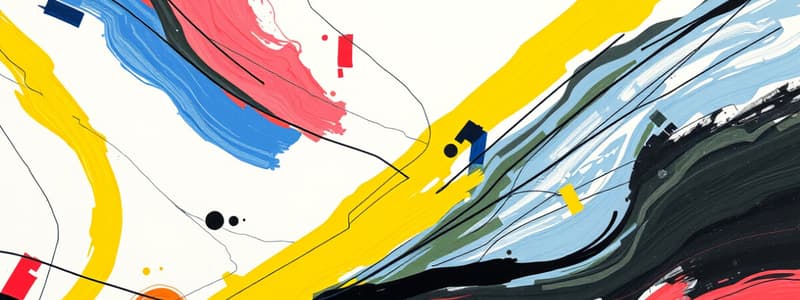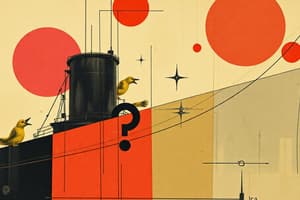Podcast
Questions and Answers
What is the definition of a line?
What is the definition of a line?
- A point set in motion
- A solid body
- The path of a moving point (correct)
- A rhythmic flow of shapes
What is calligraphy derived from?
What is calligraphy derived from?
Techniques of penmanship or writing
What is contour in art?
What is contour in art?
A line defining the outermost edge of an object
What does the term 'hatching' refer to in artistic techniques?
What does the term 'hatching' refer to in artistic techniques?
Crosshatching involves one set of hatched lines.
Crosshatching involves one set of hatched lines.
What is the illusion of a solid body in graphic arts referred to as?
What is the illusion of a solid body in graphic arts referred to as?
What is meant by 'implied line'?
What is meant by 'implied line'?
What is the effect of horizontal lines in art?
What is the effect of horizontal lines in art?
What does 'gesture drawing' prioritize?
What does 'gesture drawing' prioritize?
What characteristic does actual texture have?
What characteristic does actual texture have?
What does 'trompe l'oeil' refer to in art?
What does 'trompe l'oeil' refer to in art?
What is the purpose of using texture in art?
What is the purpose of using texture in art?
What is a pattern in art?
What is a pattern in art?
Flashcards are hidden until you start studying
Study Notes
Line
- Defined as the path of a moving point, it serves as a mark created by a tool on a surface, contrasting in value.
- Paul Klee conceptualized it as "a point set in motion," suggesting its dynamic nature.
Calligraphy
- Originates from traditional penmanship, characterized by flowing and rhythmical line qualities.
Line Quality
- Calligraphic line quality is often curvilinear and organic in feeling.
- A varied line quality can define three-dimensional forms and create emphasis in designs.
Types of Lines
- Contour: Defines the outermost edge of an object.
- Cross-Contour: Lines that illustrate surface undulations within the bounds of contours.
- Implied Line: Created when points are arranged in a manner that the eye connects them.
- Psychic Line: Occurs when one object gestures towards another, evoking a connection.
Physical Properties of Line
- Measure: Length and width.
- Type: Varieties include straight, curved, and zig-zagged.
- Direction: Movement across the picture plane.
- Location: Placement on the picture plane influences perception.
- Character: Defined by the medium used.
Drawing Techniques
- Hatching: Technique using repeated parallel strokes to create value.
- Crosshatching: Application of another set of lines in a different direction to deepen value.
Art Categories
- Representational Art: Depicts subjects that evoke recognition of actual objects.
- Nonrepresentational Art: Features non-recognizable imagery, ranging from pure abstraction to non-objective forms.
Line in Art
- Recognized as an essential, familiar element in artistic creation.
- Used in linear techniques to evoke emotional or expressive qualities.
Drawing Types
- Contour Drawing: Follows the edges of forms, outlining their shapes.
- Gesture Drawing: Focuses on conveying actions and dynamics rather than mere shapes, often created quickly.
Texture
- Refers to the surface quality of objects and can evoke a sense of touch.
- Divided into actual texture (perceived through touch) and visual texture (impression created visually).
- Natural Texture: Created by nature.
- Artificial Texture: Crafted by humans, such as in ceramics and textiles.
Pattern
- Defined as a repetitive design utilizing the same motif or element.
- Can create visual rhythm and balance, contributed to by symmetries and rotations.
Tactile Texture
- Texture that can be physically felt, enhancing the experience of artworks.
- Techniques like impasto create texture with thick paint, and collage integrates real materials to emphasize texture.
Illusion and Perspective
- Atmospheric perspective creates depth through fading colors and blurring objects.
- Techniques in painting can simulate reality using perspective and light/shade to enhance the illusion.
Composition
- Rectangular compositions naturally incorporate lines tied to geometry, while the transition from rough to smooth leads the viewer’s eye across the artwork.
Studying That Suits You
Use AI to generate personalized quizzes and flashcards to suit your learning preferences.




